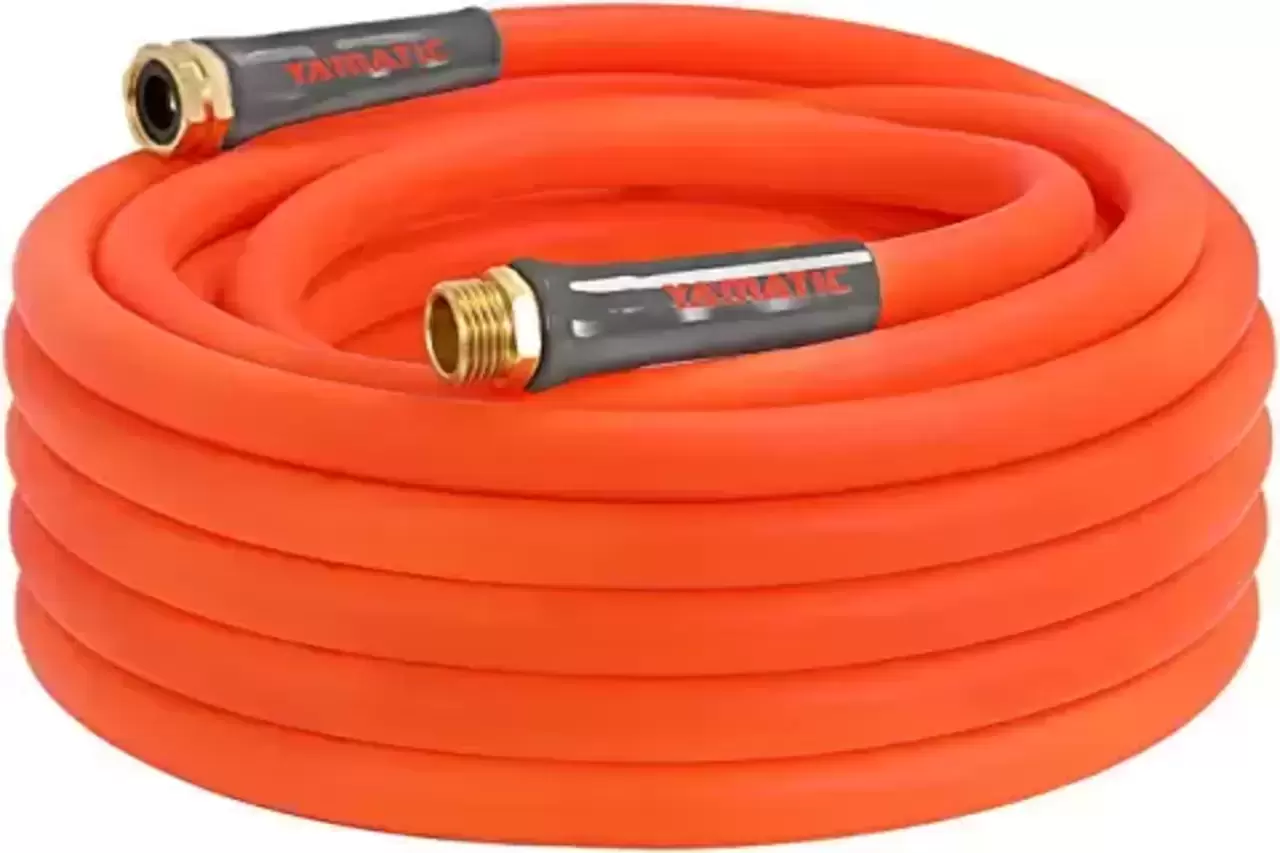When we are talking about The Best Garden Hoses, you probably already have a hose for watering the grass and potted patio plants and washing down the sidewalk. Still, if you’re like many, that hose might have hardened over the years, developed kinks that won’t straighten out, or even sprung a few leaks.
If so, don’t buy another garden hose before finding out which hoses scored the highest in my hands-on tests. I didn’t go easy on the hoses—I put them through real-world watering (and life) situations. Spoiler: Not all of them made it through.
Keep reading to learn about the new materials that go into making today’s top hoses and to find out both the pros and cons of each hose I tested. Discover the strengths and weaknesses of different types of hoses—before you invest in a new one—and learn how the following hoses earned their way onto our list of the best garden hoses.
- BEST OVERALL: Zero-G 5/8 in. D x 50 ft. Black Aluminum Garden Hose
- RUNNER-UP: Grace Green Hybrid 5/8 in. Garden Hose
- BEST BANG FOR THE BUCK: GrowGreen Expandable Garden Hose with High Pressure
- BEST STAINLESS STEEL: Bionic Steel 100-Foot Garden Hose 304 Stainless Steel
- BEST EXPANDABLE: Titan 50FT Garden Hose
- BEST DRINKING WATER–SAFE: Flexzilla Garden Hose with SwivelGrip, 5/8 in.
- BEST FLEXIBLE: Yamatic Garden Hose 5/8 in x 30 ft Super Flexible
- BEST RUBBER HOSE: Briggs and Stratton 8BS75 75-Foot Premium Heavy-Duty
- BEST LONG HOSE: Giraffe Hybrid Garden Hose 5/8″ x 100ft Heavy Duty
ALSO TESTED:
- Rocky Mountain Goods Flat Soaker Hose
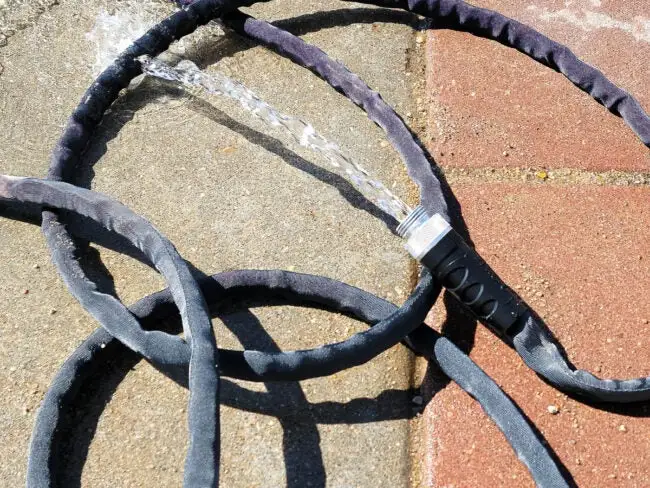
What to Consider When Choosing the Best Garden Hoses
Garden hoses come in all lengths, and some are better suited than others to particular types of watering or washing. Whether you want to connect multiple sprinklers to create a watering system that covers an entire yard, slowly soak the ground around a plant, or spray off driveways and patios, the right garden hose is out there. Here’s how to find it.
Types of Garden Hoses
In the past decade, the types of garden hoses available have grown to include lightweight, inexpensive hoses for limited watering chores and heavy-duty models for frequent or high-pressure water needs. Buyers can even find expandable garden hoses that stretch to full length when the water is on but retract to a third of that size for storage. Typical watering tasks will determine the best type of hose to choose.
- Light duty: For small yards or patios with just a few potted plants or raised beds to water, a light-duty hose may be sufficient. These hoses are typically reasonably light in weight (around 2 to 4 pounds), making them simple to coil and store on a hook in the garage.
- Standard: Also labeled as “medium duty,” these garden hoses are made for general around-the-yard lawn-watering needs. They weigh more than light-duty hoses (about 4 to 10 pounds) and, depending on length, might be better suited to storing on a hose reel rather than hanging on a hook.
- Heavy-duty: Best suited for weathering the elements and to use with pressure washers, heavy-duty garden hoses feature thicker materials and are more kink-resistant. They can cost up to twice what standard and light-duty hoses cost.
- Expandable: The new kids on the block expandable hoses are made of supple materials that shrink when not in use, and they are very lightweight—around 2 pounds or so. When filled with water, however, the hoses expand to their full length, usually 25 to 50 feet. They’re best suited for attaching to wands and sprinklers for watering pots and raised beds.
- Soaker: This hose conserves more water than any other type. Rather than spraying out water, where some will evaporate before reaching the plants, a soaker hose delivers water slowly and directly to plant roots. A soaker hose is a top option for landscaping beds, raised beds, and rows of vegetables.
- Flat: Tubular when filled with water, a flat hose returns to a completely flat shape when empty, making it easy to roll up and store. It’s suitable for basic watering and sprinkling use, and some flat hoses are designed to work as soakers.
Also Read: Best Types of Kitchen | All You Need To Know- Right Now
Length
Many garden hoses are 25 to 75 feet long, with 50 feet being the most common length. This makes them suitable for reaching most areas of an average yard. Longer hoses that are 100 feet or more in length, can be heavy, cumbersome, and challenging to roll up and store. If moving hoses around is an issue, it might be better to purchase multiple hoses in shorter lengths and then connect them when necessary to reach farther. In addition, the water flow rate drops the longer the hose measures.
For those with low water pressure at the spigot, a shorter hose is often a better choice. Shorter connecting hoses range from around 6 to 10 feet long and are designed for connecting a series of sprinklers to create an aboveground watering system.
Hose Diameter
The most common hose diameter is ⅝ inch, and it works well with most outdoor water supply sources. Wider hoses—up to 1 inch in diameter—will deliver more water volume-wise, but the pressure of the water as it exits the hose will drop. When choosing a wide hose, ensure there’s ample water pressure at the spigot. Narrow hoses, less than ½ inch, are well suited to spigots with low water pressure.
Keep in mind that the hose attachment fittings might differ in size from the hose diameter—most attachments are designed to fit standard ⅝-inch connectors, but a few will fit ¾-inch connectors. Some manufacturers include a fitting adjuster that allows connections to both sizes of fittings. If not, adjusters are readily available in hardware and home improvement centers.
Material
Being waterproof and flexible are the two most important aspects when it comes to selecting hose materials.
- Rubber: Among the most durable choices for a garden hose, rubber is optimal, but it tends to be heavier than other materials and can cost more. Premium hoses often contain rubber.
- Vinyl: Flexible and lighter in weight than rubber, vinyl is a popular choice of hose manufacturers. It may come with embedded mesh to give it added strength and durability.
- Latex: Similar to vinyl, latex is flexible and waterproof. It is often used in garden hoses that feature a protective cover of some type.
- Polyurethane: When paired with flexible additives, polyurethane creates a waterproof hose that resists leaks and kinks.
- Reinforced: Often paired with vinyl hose material, reinforcing can be attained by encasing the inner hose with solid rings or covering it with rugged woven fibers for added strength.
- Stainless steel: Coils of stainless steel surround a waterproof membrane to create a rugged, durable hose that’s still flexible. A stainless steel hose is most often used for hand-watering, but it can also work with sprinklers.
- Drinking water–safe: Those who want to get a quick drink from the hose on a hot day of landscaping or working on projects might want to consider a drinking water–safe hose that will neither leach contaminants into the water nor affect its taste.
As you can see above that, most hoses are made from durable, synthetic materials like PVC and latex. Some have the additional benefit of being drinking water safe, a certification extended by the product testing organization NSF International. Lauri Kranz, a co-author of A Garden Can Be Anywhere and the founder of the garden-planning and organic-food-delivery service Edible Gardens LA, recommends using a food-safe hose for watering edible crops. “The water coming through that hose is water that is going directly into the food we eat,” she says.
Strength
Some garden hoses (not all) come with a pressure rating, called “burst pressure,” which denotes how much internal water pressure the hose will handle before bursting. Water pressure at the spigot for most residential homes is between 45 and 80 pounds per square inch (psi), but the actual water pressure in the hose can reach much higher if the spigot is left on and the hose is filled with water.
Most residential hoses should have a burst pressure rating of at least 350 psi if they’re going to be used frequently. Inexpensive hoses may feature burst pressure ratings of as low as 200 psi, while top-of-the-line hoses can come with burst pressure ratings up to 600 psi.
A few hoses list working pressures rather than burst pressures, and these are substantially lower, from about 50 to 150 psi. They only indicate the average amount of pressure the hose is designed to hold while water is flowing in and out. Working pressure of 80 psi or higher is recommended.
Couplings
Brass, aluminum, and stainless steel couplings, or fittings, will last the longest and are available on many medium- and heavy-duty hoses. Light-duty hoses might come with plastic fittings, and they typically do not last as long as higher-quality fittings. In addition to screw-type fittings, some hoses come with quick-connect push-type fittings that make it simple to attach and disconnect the hose from the spigot or other hoses.
When buying hoses, keep in mind whether you’ll need to connect two or more hoses together. Many hoses feature couplings on both ends, but some soaker-type hoses have only one fitting—the one that connects to the water source. If you need to connect a series of soaker hoses, be sure to look for models that have couplings on both ends.
Safety
In general, hoses are one of the safest yard and garden tools around, but for those who fill pets’ watering bowls or drink from the end of the hose, a drinking water–safe hose is the way to go. A growing number of manufacturers are making drinking water–safe hoses that do not contain any chemicals that might leach into the water, so the water is just as safe when it leaves the end of the hose as when it enters. These hoses are often labeled “BPA-free,” “lead-free,” and “phthalate-free.”
Also Read: Best Engineering Books For Engineers
Our Top Picks
To qualify as a top pick, the following garden hoses had to be strong, flexible, and durable and come with easy-to-attach (leak-free) fittings. I tested each of the following hoses at 55 pounds per square inch (psi) water pressure, which is standard to a little on the strong side for the average outdoor spigot.
I wound the hoses in tight configurations, pulled them about the yard—and then backed over them with a car (because that happens). I put them through their paces—and the ones that survived truly earned their spot in this lineup. I feel confident that any of the following hoses will be a beneficial addition to this year’s lawn and a gardening arsenal of tools and supplies.
Full Disclosure: Please note that this post includes affiliate links. It simply means if you click on these links and decide to make a purchase, at NO additional cost to you (none whatsoever!), I may get compensated by the affiliate program. Will this be a problem? If you click and buy, thank you. I really appreciate it.
So, let’s get started with The Best Garden Hoses of 2022.
1. Garden Hoses: Best Overall
- Zero-G 5/8 in. D x 50 ft. Black Aluminum Garden Hose
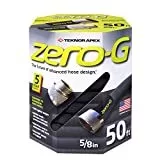
Out of the box, the Zero-G hose was plain-looking and unimpressive—just a wrinkly gray hose that was problematic to untangle. Wow, are first impressions ever deceiving! Despite its initial drab debut, this hose ended up taking the top spot in the lineup.
Once I got the hose untangled—note to manufacturer: a different packaging configuration might help—I attached the hose to the spigot, put a closed nozzle on the other end, and turned the water pressure up to full force. The wrinkly Zero-G hose transformed into a super-resilient hose that refused to kink, even when I looped it into a knot and pulled on the end. Impressive.
The Zero-G hose also stood up to being stretched across the driveway and then backed over without any sign of damage. The hose comes with a flexible inner vinyl core and is encased in a thick layer of high-density woven fibers that reinforce and protect the hose.
The Zero-G hose has a high 600-psi burst rating and is one of the most robust hoses. Yet it remains flexible—I found that its flexibility didn’t depend on outdoor temperatures; it maintained uniform flexibility in warm and cool weather. The attachment fittings are made from rugged aluminum for strength and come with brass inserts for durability. I had no problems with leaks, either at the fixture or where I connected a nozzle.
Product Specs
- Length: 50 feet
- Diameter: ⅝ inch
- Material: Vinyl core with high-density fiber sheath
Pros
- Very durable
- No-leak fittings
- Flexible
- Doesn’t kink
Cons
- Challenging to untangle it initially
2. Garden Hoses: Runner-Up
- Grace Green Hybrid 5/8 in. Garden Hose
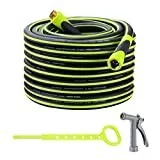
The flexible Grace Green Garden hose is kink resistant and remains supple in cooler temperatures. I tested that premise outdoors when the temperature was just 43 degrees Fahrenheit, and it’s true—Grace Green was flexible enough to easily loop around the base of a flagpole without kinking. The hose is ⅝ inch in diameter but just 10 feet long (though other lengths may be available), so it’s best suited as an extension to connect another hose or for watering a small area, such as potted plants on a balcony.
The Grace Green Garden Hose comes with crush-resistant attachment fittings, but the nonslip, ergonomic grips located at both ends were my favorite feature. Who hasn’t struggled to loosen (or tighten) metal hose fittings and come away with sore fingers? That’s a thing of the past with the Grace Green hose fittings that allowed me to attach the hose using my entire hand to turn the comfortable grips.
The hose withstood the full force of the water pressure, even when backed over with the car—no leaks and no tears. I did experience a spurt out of the fitting when I connected the hose to a spray nozzle (not included), but upon inspection, that was the fault of the rubber washer having fallen out of the nozzle—it wasn’t a hose issue. Once I replaced the washer, there were no leaks.
A nice bonus is the hanging hose holder that allows users to stow the hose on a fence post or even a large hook.
Product Specs
- Length: 10 feet
- Diameter: ⅝ inch
- Material: Multilayer latex core and polyester sheath
Pros
- Flexible even in cool temps
- Nonslip end grips
- Included hanging strap
Cons
- Advertised as “sprayer included” but didn’t receive one
3. Garden Hoses: Best Bang for the Buck
GrowGreen Expandable Garden Hose with High Pressure
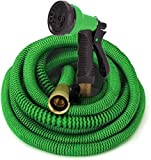
A decent garden hose doesn’t have to stretch the budget. The first thing I noticed about the GrowGreen Expandable Garden Hose was how soft and floppy it was—my first impression was that it might not be strong enough to withstand average outdoor spigot water pressure. I need not have worried. The hose expanded to 50 feet long when filled with water, and the floppiness was gone. I was hesitant to back over this hose with my car, but it survived without damage.
The GrowGreen features latex inner tubing and an outer protective covering made from woven fibers. It comes with solid brass attachment fittings that didn’t leak when connected to the spigot or the included spray nozzle. The spray nozzle itself is just okay. It’s made from molded plastic and features eight spray patterns, which all served their purpose, but a small amount of water trickled from the head of the nozzle no matter which pattern I chose. I ended up with a wet shirtsleeve, but I didn’t subtract points because I was testing hoses after all, not nozzles.
Be aware that the GrowGreen isn’t suitable for use with lawn-type sprinklers because the hose is in retracted mode until it fills with water. To supply water to a sprinkler, one of the other hoses in this lineup would work better.
Product Specs
- Length: 50 feet
- Diameter: ⅝ inch
- Material: High-pressure latex core, woven nylon sheath
Pros
- Lightweight and easy to store
- Durable
- Shut-off valve on end fitting
Cons
- Dribbly spray nozzle
4. Garden Hoses: Best Stainless Steel
- Bionic Steel 100-Foot Garden Hose 304 Stainless Steel
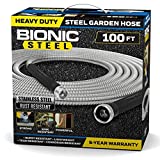
Shiny, slinky, and excellent grips were my first impressions of the Bionic Steel Garden Hose, and I didn’t change my mind about it even after extensive testing. I’d never used a stainless steel hose before, so I wasn’t sure what to expect, but the Bionic Steel hose came through with flying colors.
It comes with brass fittings and ribbed rubber sleeves at each end that provides a sturdy, nonslip hold while attaching the hose to the spigot or nozzle. Without water, the Bionic Steel hose is rather limp and slippery and just carrying it was interesting since it wanted to slip out of my arms. Once it was filled with water, I understood what the hype was all about. The Bionic Steel hose remained flexible enough to pull it around corners, and it didn’t kink, although I tried to loop it into a knot.
I thought about skipping the test where I backed over it with a car—after all, steel bends—but I knew I had to do it. I stretched the Bionic Steel hose across the driveway and drove over it. Surprisingly, it didn’t bend at all. I did the drive-over test with a compact car, so I can’t say what would happen with a full-size pickup, but I was pretty impressed. I expected some compression, at least.
This is a powerful hose, but it’s not heavy despite having a protective sheath made from stainless steel. When empty, the hose weighs just 3 pounds. It winds nicely around hose reels and keeps its shape.
Product Specs
- Length: 100 feet
- Diameter: ⅝ inch
- Material: Reinforced vinyl core, stainless steel sheath
Pros
- Won’t kink
- Strong and durable
- Nonslip grips at ends
- Flexible
Cons
- Slippery to carry—slides right out of arms
5. Garden Hoses: Best Expandable
- Titan 50FT Garden Hose
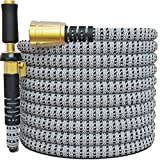
Small brass hose fittings can be troublesome when attaching a hose to a spigot, but that’s not a problem with the Titan Garden Hose which comes with one of the handiest fittings I’ve ever seen. The connective fitting is solid brass, and it’s more than double the size of a standard fitting. It was large enough to turn it using my entire hand, not just my fingers. Best of all, it didn’t leak.
The fitting is also solid brass but of standard size on the nozzle end. The Titan hose comes with an included nozzle that I feel is almost worth the price of the hose itself. The nozzle is brass and features a smooth-twist spray adjustment. However, the nice part is that the nozzle is coated in nonslip rubber, both on the tip of the nozzle and on its fitting. This made connecting the nozzle to the end of the hose easy and comfortable. Again, no leaks at this fitting. A nice bonus is the shutoff valve on the hose’s end fitting—it allowed me to switch nozzles
without turning off the water at the spigot first.
Like the other hoses, the Titan passed the test of being backed over by the car, and it also passed the kink-free test. When it’s not filled with water, the hose is super-lightweight and flexible. I tossed it in a 10-inch-by-10-inch box, and it settled in nicely. The only downside—and it was slight—was that the outer woven nylon sheath suffered a little snag when I pulled the hose around the outside of a brick planter. The snag didn’t affect the hose’s performance, however.
Product Specs
- Length: 50 feet
- Diameter: ⅝ inch
- Material: Flexible polyurethane inner core, exterior woven nylon sheath
Pros
- Stores in small space
- Excellent larger fitting
- Rubber-coated, high-quality nozzle included
Cons
- Nylon exterior snagged
6. Garden Hoses: Best Drinking Water Safe
- Flexzilla Garden Hose with SwivelGrip, 5/8 in.
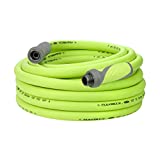
Hose-testing can work up a thirst, so I was more than happy to take a drink out of the end of the Flexzilla Garden Hose. However, keep in mind that drinking water hoses are only as safe as the water they’re carrying. In addition, a hose left outdoors can become contaminated with bacteria over time, so consider that before taking a sip.
The Flexzilla hose is ⅝ inch in diameter and measures 50 feet long, although a few other sizes may be available. It’s heavy-duty yet lightweight at just 8 pounds, and I found it easy to loop and store on a wall hook in the garage. The Flexzilla remained flexible in cool temps in the lower 40s, and it resisted kinking, although it finally formed a kink after I knotted the hose and pulled on it. However, it took some effort on my part to make it kink.
My favorite part was the hose’s SwivelGrip action, which allowed me to attach and detach the fittings from the spigot and the nozzle with ease. The hose is made from a flexible hybrid polymer designed to remain supple even in cold weather, and it didn’t suffer from being driven over by my car. This is an all-around top garden hose with a chemical-free inner core that makes it preferable for watering pets and allowing children to enjoy playing in the sprinkler.
Product Specs
- Length: 50 feet
- Diameter: ⅝ inch
- Material: Hybrid polymer core with reinforced sheath
Pros
- Flexible
- Nonchemical-leaching inner core
- Comfort swivel grips
Cons
- The neon green color stands out like a sore thumb
7. Garden Hoses: Best Flexible
- Yamatic Garden Hose 5/8 in x 30 ft Super Flexible
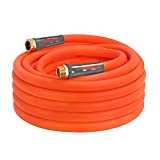
The manufacturer claims the Yamatic Garden Hose comes with exclusive No Permanent Kink Memory (NPKM), which keeps the hose from kinking and twisting on itself. I tend to agree. Just by turning on the water, the pressure straightened out the hose, but it was still flexible enough to curl around the base of a tree. It was just as flexible at 40 degrees Fahrenheit as it was at 60 degrees. Initially, the connection to the spigot was leaky, and either the washer fell out of the fitting, or it was never in the fitting. Still, by borrowing a washer from another hose, I could attach the Yamatic hose without leaks.
The hose easily withstood being backed over by the car, and it didn’t kink when I looped it into a knot and pulled the end. Both ends of the hose have nonslip grips that make attaching the hose to the spigot and nozzles easier.
The Yamatic hose is ⅝ inch in diameter and 30 feet long. It’s made from bright orange polyurethane infused with UV protectants to keep the hose flexible and supple longer. The color is a little bright for my taste, but it won’t get lost in the garden. It comes with solid brass connectors and weighs 8.21 pounds.
Product Specs
- Length: 30 feet
- Diameter: ⅝ inch
- Material: Flexible hybrid material throughout
Pros
- Kink resistant
- Durable
- Flexible even in chilly temps
Cons
- Neon orange (although some may like this)
8. Garden Hoses: Best Rubber Hose
- Briggs and Stratton 8BS75 75-Foot Premium Heavy-Duty
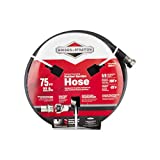
I’m sold on the Briggs & Stratton Premium rubber garden hose for durability and sheer strength. What a hose! I twisted it, looped it into a knot, and pulled hard, but it resisted kinking and was still flexible at 40 degrees Fahrenheit, though not quite as flexible as it was at 60 degrees. This is an industrial-style hose, and it’s suitable for use with power washers, sprinklers, handheld nozzles, and wands. The manufacturer claims it will withstand up to 500 psi of water pressure without bursting, and it indeed withstood being driven over without any visible damage.
It’s not the lightest-weight hose I tested. The ⅝-inch Briggs & Stratton hose is 75 feet long and weighs 14.06 pounds. I was able to wind it up around a hose reel, but if you’re looking for an easy-to-stow hose, this isn’t the one. It comes with crush-resistant, nickel-plated brass attachment fittings, and while it doesn’t feature any additional grips, the fittings are high quality, and I had no problem attaching or detaching them.
I found no leaking at either the spigot or the nozzle end, and when the hose was filled with water, I could still curl it around the base of a tree. It’s a little stiffer than the other hoses in this lineup, but that’s likely due to its thick rubber nature. All in all, this is an industrial-strength hose that I’d trust for the most challenging watering situations.
Product Specs
- Length: 75 feet
- Diameter: ⅝ inch
- Material: Rubber
Pros
- Very durable
- High-quality fittings
- Made for industrial use
Cons
- Slightly stiffer at cold temps
9. Garden Hoses: Best Long Hose
- Giraffe Hybrid Garden Hose 5/8″ x 100ft Heavy Duty
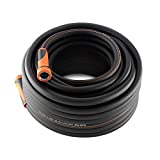
For watering large yards, consider the Giraffe Hybrid Garden Hose, which is flexible and designed for heavy-duty use. It measures 100 feet long, although shorter lengths may be available, and comes in the standard ⅝-inch diameter, although the one I tested is noticeably smaller in diameter than other ⅝-inch hoses. It came out to be just a hair more than ½ inch in diameter when I measured. I don’t know if this holds true for all Giraffe Hybrid hoses or if I just got one on the narrower side. Not that it mattered in testing; this hose still performed exceptionally well.
At 100 feet, this hose is pretty long, but its smooth, flexible nature seems to help keep it from tangling. It’s kink resistant; even after I looped a knot in it and pulled, it didn’t kink. It features nickel-plated brass fittings and ergonomic hand grips at each end, making it simple to attach the hose to the spigot and to various nozzles. I was able to attach it to both without any leaks.
The Giraffe hose is made from three layers of hybrid polymer—an inner layer that keeps it supple, a woven layer to prevent kinking, and a top layer for durability and abrasion resistance. Being backed over by my car didn’t seem to faze this hose. After use, I was able to wind it around my hose reel, but like the other large hoses, it’s not a space saver—it takes up some room.
Product Specs
- Length: 100 feet
- Diameter: ⅝ inch (more like ½ inch)
- Material: Flexible polymer, reinforced polyester inner layer
Pros
- Kink resistant
- Strong and durable
- Leak-free fittings
- Nonslip end grips
Cons
- Not as wide as advertised
Also Tested
- Rocky Mountain Goods Flat Soaker Hose
I really wanted to like the Rocky Mountain Goods Flat Soaker Hose. Having used and tested soaker hoses in the past, I knew not to turn up the water pressure all the way—soaker hoses have perforations that create weak spots. But, alas, I hadn’t turned up the pressure more than just a tiny bit when the seam on the hose blew out completely—water just ran everywhere.
After turning off the water and checking the hose, I’m not sure if that seam area was ever sewn completely shut—it didn’t look like it. I’m putting the failure down to a factory defect this time. Soaker hoses serve to deliver water right to the roots of a plant where the water isn’t wasted by evaporation. I’ve used many, and they’re an eco-friendly way of watering plants and gardens.
Our Verdict
While many of the garden hoses that made our lineup are winners in their own categories, our Best Overall pick, the Zero-G Garden Hose, ticks all the boxes. What started out looking like nothing more than a wrinkly gray hose turned out to be a robust, top performer that held up to all my tests. Coming in as Runner-Up, the Grace Green Hose is also an excellent pick. Although I tested a short 10-foot version, its durability, and flexibility clearly stood out.
How We Tested the Best Garden Hoses
While garden hoses are far from complicated products, getting a substandard one can be frustrating. I wanted to test the most popular hoses on the market and see if they lived up to the manufacturers’ hype. To that end, I tested them for flexibility, durability, and whether they could withstand a normal-to-high amount of water pressure without damage. I also carefully examined the quality of their fittings. I used a rubric and awarded each hose points based on its performance in each category.
The tests included driving over a filled hose, tying the hose in a knot and turning the water on to see if it formed a fatal kink, and pulling the hose forcefully around planters, bushes, and curbs.
At the end of the testing, the hoses that didn’t make it were eliminated, and the scores for surviving hoses were tallied and used to help determine the award categories.
I’m not sure what I thought when I started the tests, but in the end, I was amazed at how much better the quality of today’s garden hoses is than those I’ve used in the past. The ones that made this lineup genuinely deserve to be in it.
FAQs
A few questions are to be expected from those looking to buy a quality garden hose that suits their needs. The type of anticipated watering chores will help determine the type and size of the hose.
Q. What size hose should I buy?
For most residences, a hose that’s ⅝ inch in diameter is sufficient for watering tasks. Standard hoses come in 25- to 75-foot lengths, so consider the size of the yard when buying. Naturally, a longer hose takes up more space for storage and is heavier to lug around, so factor that in as well.
Q. How do I reduce and get rid of kinks in my hose?
A high-quality hose is less likely to kink than an inexpensive model, but all hoses will benefit from stretching the hose out straight after use and then looping it in large 2- to 3-foot loops before hanging it on a large hook. Alternatively, a garden reel that winds and stores the hose will also help reduce kinks.
Q. Do I need a garden hose nozzle for my hose?
If you want to water potted plants and other areas of the garden by hand, a nozzle is the best option. You can adjust the flow right at the plant and close it when pulling it around the yard or patio.
Q. What’s the best way to store my hose and extend its longevity?
Even the most durable hoses will last longer if they’re not left out in the elements. To get the most use out of a hose, store it either in a garage, storage shed, or basement when not in use.
We hope this article helped you learn about The Best Garden Hoses. You may also want to learn about What is the Function of Buildings? , Cladding: Types and Considerations, Structural Engineers, and Aluminium and Copper as Building Materials.
If you liked this article, please Join WebsiteForEngineers on Telegram, and you can also find us on Pinterest, Twitter, and Facebook.
